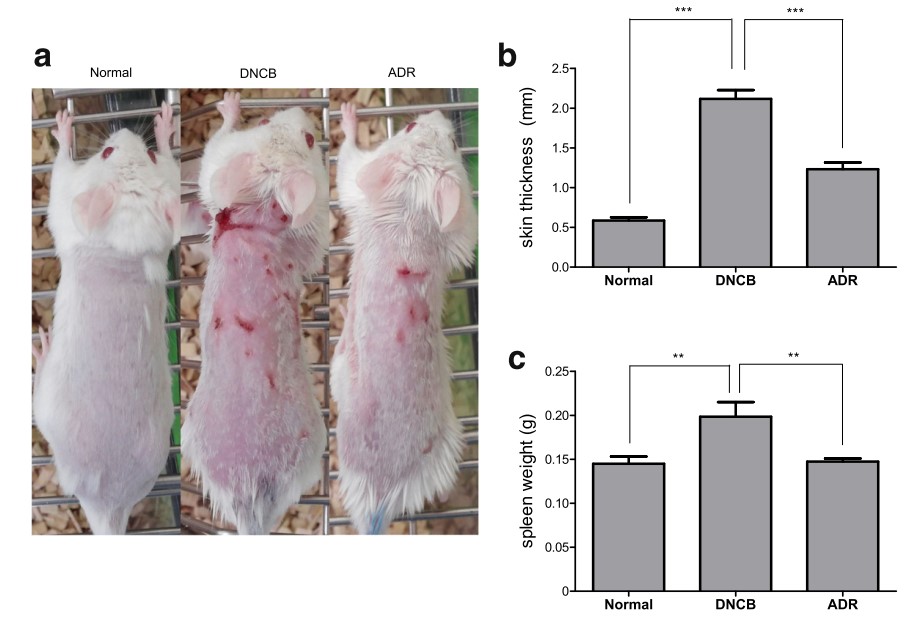Skin Disease Model Construction Service for Exosome Functional Research
Overview Services Features FAQs
Overview
The Potential of Exosomes for Skin Issues
With the deepening of research, exosomes have been proven to be unique lipid vesicles that can deliver various bioactive molecules, such as proteins, drugs, and microRNA, and have functions such as participating in intercellular communication, regulating the immune system, and transporting substances. In recent years, researchers have discovered that exosomes play a significant role in both the physiological and pathological processes of the skin and have established a connection between exosomes and skin diseases.
-
In normal skin physiology, exosomes help regulate cytokine secretion within the skin microenvironment, promote angiogenesis and collagen deposition in areas of skin damage, and influence the proliferation and differentiation of skin fibroblasts.
-
In pathological conditions, exosomes can contribute to the development of various skin disorders, such as hypertrophic scars, skin sclerosis, and dermatitis.
Excitingly, more and more studies suggest that natural or engineered exosomes can effectively penetrate lesions to treat these skin diseases. Establishing a suitable animal model of skin diseases is a favorable bridge to studying the efficacy evaluation of exosome drugs. Creative Biolabs has been concerned with skin care-related research and can provide the most comprehensive one-stop service for exosome research, including exosome extraction, exosome identification, exosome engineering, exosome labeling, and in vivo and in vitro verification of exosomes, to help customers further transform their achievements.
 Fig.1 Observations of skin lesions in ADR (200 mg/kg) treated DNCB-induced AD mice.1,2
Fig.1 Observations of skin lesions in ADR (200 mg/kg) treated DNCB-induced AD mice.1,2
Services
Creative Biolabs Skin Disease Model Library for Exosome Functional Research
Features
-
A diverse range of animal models for skin diseases
-
Comprehensive services from the development of the experimental plan, execution of the experiment, to data analysis.
-
Flexibly design project plans based on communication with the client and their objectives.
-
Efficient exosome extraction, purification, labeling, and in vivo functional research
Animal experiments are an important part of pharmaceutical research and development. Appropriate animal models can help researchers to more effectively understand the development of human diseases and evaluate candidate drugs. Creative Biolabs has been focusing on the development of exosome drugs in the field of skincare and skin diseases. Our animal experiment team with many years of working experience can strictly control every link for animal modeling and animal experiments. Please contact us to put forward your ideas about animal experiments, and we will recommend the most suitable animal models for skin diseases and formulate the most rigorous in vivo efficacy evaluation plan for you.
FAQs
Q: What is the potential of exosomes in treating skin diseases?
A: Exosomes, particularly those derived from stem cells, hold significant potential for treating skin diseases. They can transport various bioactive molecules (such as proteins, mRNA, and miRNA) that play key roles in intercellular communication and regulation. Exosomes can be crucial in addressing a range of skin conditions—including atopic dermatitis, wound healing, and skin aging—by promoting skin regeneration, reducing inflammation, repairing damaged tissues, and modulating immune responses.
Q: How do I choose the appropriate animal model for exosome research on skin diseases?
A: The selection of an appropriate animal model depends on your specific research goals and the type of skin disease being studied. Our scientific team will collaborate with you to understand your research needs and recommend the most suitable animal model based on the disease's pathological characteristics, experimental objectives, and budget.
Q: What are the sample requirements for exosome research services?
A: We recommend that clients consult with our team before providing exosome samples to ensure that their quality and quantity meet the necessary experimental requirements. Generally, samples should be efficiently extracted and purified, and they must remain stable during transportation and storage. We can also provide specific guidance on sample handling to ensure optimal experimental results.
References
-
Ku, JM.; et al. Effects of angelicae dahuricae radix on 2, 4-dinitrochlorobenzene-induced atopic dermatitis-like skin lesions in mice model. BMC Complementary and Alternative Medicine. 2017, 17(1):98.
-
Distributed under Open Access license CC BY 4.0, without modification.
For Research Use Only. Cannot be used by patients.
Related Services:

 Fig.1 Observations of skin lesions in ADR (200 mg/kg) treated DNCB-induced AD mice.1,2
Fig.1 Observations of skin lesions in ADR (200 mg/kg) treated DNCB-induced AD mice.1,2









